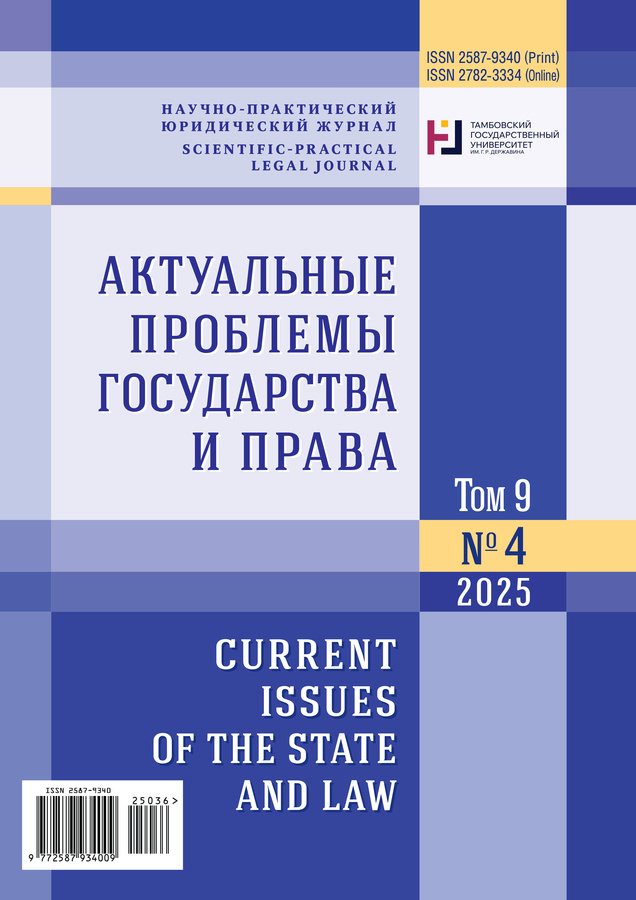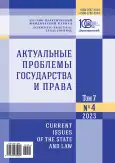Институт соучастия в российском уголовном праве на современном этапе
- Авторы: ВАСИЛЕНКО А.С.1
-
Учреждения:
- ФГАОУ ВО «Российский университет дружбы народов им. Патриса Лумумбы»
- Выпуск: Том 7, № 4 (2023)
- Страницы: 578-585
- Раздел: Материальное право
- URL: https://journal-vniispk.ru/2587-9340/article/view/303746
- ID: 303746
Цитировать
Полный текст
Аннотация
Рассмотрена тема соучастия в преступлении, актуальность которой не вызывает сомнений и подтверждается приведенными статистическими данными, а также приведенным освещением дискуссионных вопросов, связанных с заявленной тематикой. В качестве объекта исследования выступают общественные отношения, связанные с выявлением и установлением ответственности за умышленное совместное участие двух или более лиц в совершении преступного деяния. Предмет исследования составили доктринальные подходы к соучастию и его формам, нормы отечественного уголовного законодательства, регламентирующего ответственность за умышленное совместное участие двух или более лиц в совершении преступления, а также практика правоприменения этих норм. Цель исследования предполагает комплексное изучение института соучастия в преступлении в российском уголовном праве. Проанализированы виды (исполнитель, организатор, подстрекатель и пособник) и формы (группа лиц без предварительного сговора, группа лиц по предварительному сговору, организованная группа, преступное сообщество) соучастия. В заключение отмечено, что правовая природа соучастия базируется на признании в доктрине уголовного права двух групп признаков – объективных и субъективных, которые имеют значение для определения количественного состава преступников, их умысла на совершение преступления, связи между ними.
Ключевые слова
Об авторах
Александра Сергеевна ВАСИЛЕНКО
ФГАОУ ВО «Российский университет дружбы народов им. Патриса Лумумбы»
Автор, ответственный за переписку.
Email: vasilenko-as@rudn.ru
ORCID iD: 0000-0003-4029-8502
Scopus Author ID: 57191278848
кандидат юридических наук, доцент, доцент кафедры уголовного права, уголовного процесса и криминалистики
Россия, Российская Федерация, 117198, г. Москва, ул. Миклухо-Маклая, 6Список литературы
- Пинчук В.И. Соучастие в преступлении. СПб.: С.-Петерб. юрид. ин-т ген. прокуратуры РФ, 2002. 44 с.
- Шеслер А.В. Особенности причинной связи при соучастии в преступлении // Уголовная юстиция. 2022. № 19. С. 33-38. https://doi.org/10.17223/23088451/19/6, https://elibrary.ru/bkdmxu
- Шеслер А.В. Соучастие в преступлении. Новокузнецк: Кузбас. ин-т ФСИН России, 2014. 83 с.
- Берсенев А.А., Мирошниченко А.В. История становления и развития форм соучастия в преступлении в российском уголовном законодательстве и праве // Международный журнал гуманитарных и естественных наук. 2022. № 5-2 (68). С. 214-216. https://doi.org/10.24412/2500-1000-2022-5-2-214-216, https://elibrary.ru/jjfpiu
- Грудинин Н.C. Институт соучастия в преступлении в российском уголовном праве // Вестник Московского университета МВД России. 2022. № 2. С. 71-74. https://doi.org/10.24412/2073-0454-2022-2-71-74, https://elibrary.ru/gmrhdn
- Прозументов Л.М. Организованная группа как форма соучастия в преступлении в действующем российском законодательстве // Вестник Томского государственного университета. Право. 2015. № 4 (18). С. 60-69. https://doi.org/10.17223/22253513/18/8, https://elibrary.ru/vavpjd
- Пионтковский А.А. Учение о преступлении по советскому уголовному праву. М.: Госюриздат, 1961. 666 с.
- Тельнов П.Ф. Ответственность за соучастие в преступлении. М.: Юрид. лит., 1974. 208 с.
- Козлов А.П. Соучастие: традиции и реальность. СПб.: Изд-во «Юридический центр Пресс», 2001. 359 с.
- Колесникова Т.В. Соотношение уголовно-правовых и криминалистических признаков организованной преступной группы и преступного сообщества // Право и политика. 2010. № 5. С. 944-952. https://elibrary.ru/neyfnf
- Кисин А.В. Признаки организованной преступной группы // Всероссийский криминологический журнал. 2011. № 2. С. 85-90. https://elibrary.ru/nudsov
- Ныркова Н.А. Преступное сообщество (преступная организация): вопросы толкования и влияния на ответственность // Вестник российской таможенной академии. 2008. № 3. С. 75-81. https://elibrary.ru/kcpxrr
- Благов Е.В. Преступное сообщество (преступная организация): проблемы понимания // Научный вестник Омской академии МВД России. 2020. Т. 26. № 4 (79). С. 68-72. https://doi.org/10.24411/1999-625X-2020-11011, https://elibrary.ru/pejsdt
Дополнительные файлы










